Is a Ball Python right for me?
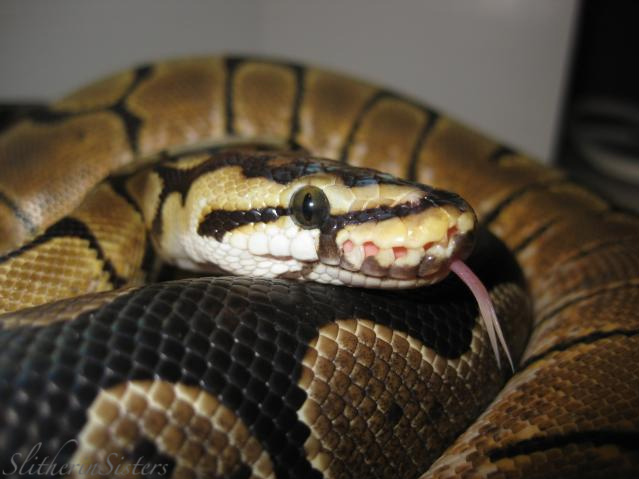 will not be seeing your BP very often. A snake that does not feel secure may not eat and can eventually die from the stress/lack of food. If you want a display tank I really suggest getting a different kind of snake or reptile. You must keep your BP's needs before your wants!
will not be seeing your BP very often. A snake that does not feel secure may not eat and can eventually die from the stress/lack of food. If you want a display tank I really suggest getting a different kind of snake or reptile. You must keep your BP's needs before your wants! Although the ball python is considered a beginner snake, I believe the only reason is because of their docile temperaments and fairly simple habitat requirements when compared to other snake species. They aren't exactly easy keepers, especially not as babies! They can be finicky about their habitat and only have a 20 degree range of safe living temperature (household temperatures are too low). If their habitat requirements aren't met they may not eat. This can be very frustrating for a new snake owner because they will starve to death, it's very important to get their habitat set up correctly. Sand Boas on the other hand, are definitely beginner snakes. They are much more forgiving if you don't get their habitat exactly right and they stay relatively small.
Basic Ball Python Information
*disclaimer* caring and husbandry practices do change over time as hobbiests learn more about BPs.
When I learn of a change I will try and update my information as soon as possible.
1. Have a proper tank/tub set up so your bp feels safe and secure. Don't put it in a huge tank.
3. Use proper feeding techniques. Only offer prey once a week if they aren't eating, offer the proper size, and offer live if they won't take frozen thawed. (Look at my feeding tips page for more info)
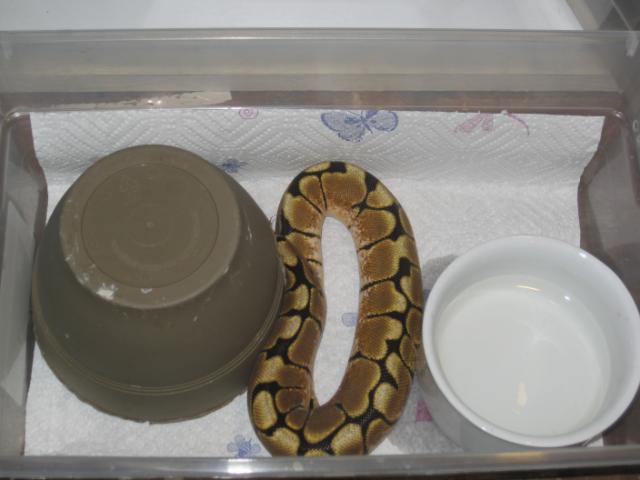
Heating
I suggest using under the tank heat (UTH), you can also run it as back heat in a rack. You can use a heat lamp, but you are almost guaranteed to have humidity problems which leads to bad/stuck shed (a shed that comes off in pieces). In
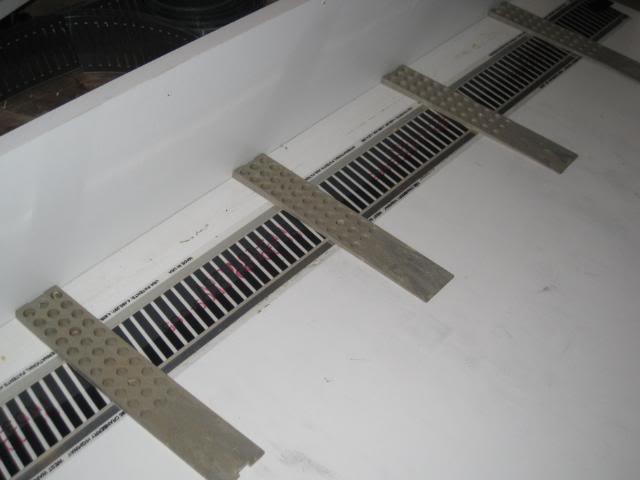 many cases you won't be able to keep the temps high enough with just a UTH in a tank so a heat lamp may be necessary as well. The picture is of a homemade rack I made. Those are composite window shims to keep the tubs from rubbing on the flexwatt. The flexwatt will wear down and shock you if the tubs rub on them too much.
many cases you won't be able to keep the temps high enough with just a UTH in a tank so a heat lamp may be necessary as well. The picture is of a homemade rack I made. Those are composite window shims to keep the tubs from rubbing on the flexwatt. The flexwatt will wear down and shock you if the tubs rub on them too much.There are all sorts of under the tank heaters, the most common UTH is a reptile heat pad that can easily be found at a pet store. You want the tub/tank where your snake lays to be about 88-92 degrees. This should be the temp that the tub floor is, not the temp of your heat tape/UTH (you may need to get a thermostat or at the very least a dimmer to control the heat). My heat tape is set at about 96 which is too hot for a BP, but you lose some heat because the tubs have air gaps. It's ok if your temps slightly vary throughout the day, BPs are hardier than people give them credit for! Don't let your temps go above 95 or below 70 (I prefer not below 75). Above 95 and you might have cooked snake, below 75 you might deal with respiratory infection. I prefer my cool side to be 75-80 degrees.
My typical temps:
88-92 hot side
75-80 cool side
Do NOT use heat rocks, they are known as death rocks for a reason. They get far too hot for ball pythons and will burn your snake. For some reason they will lay on things that burn them, don't ask me why.
Humidity
Humidity is important because it helps your snake to have proper sheds. If the humidity is too low your snake will most likely have issues with shedding. If your humidity is too high you run the risk of scale rot. This is a disease that affects the underside of your snake by literally rotting off the scales. If your snake gets scale rot you will need to get medication from a vet. 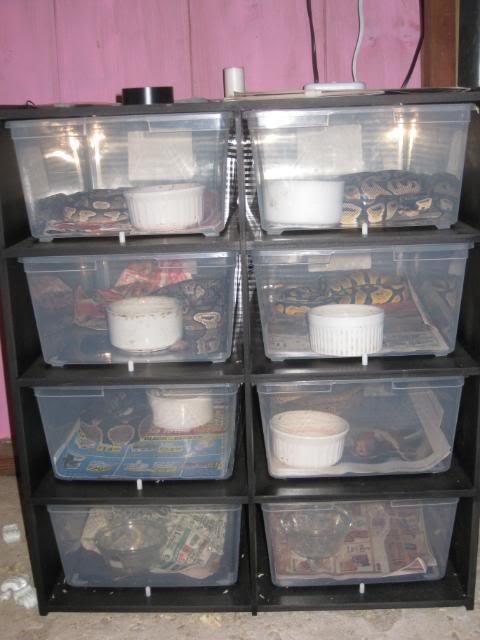
A good humidity target is 60-70% humidity. My humidity stays pretty constant at 70%. You can raise and lower your humidity levels by adjusting how much airflow your set up has. Because I use tubs I can put more holes in the tubs or cover them as necessary. Using tubs without heat lamps, I've only had an issue with humidity in the winter when I have a space heater running in the snake room.
If you have a tank set up with a heat lamp you will most likely have humidity problems. One thing you can do is put plastic wrap on the top of your tank, make sure to not put it near or under your heat lamp. If this doesn't bump your humidity up enough you could also put a larger water bowl in and put it on the warm side. Many people will also mist their tanks every day, it's a pain, but it's an option. I will sometimes spray the snakes that are about to shed in the winter when I have shedding problems.
Hide
Hides can be made from all sorts of things, or bought from a pet store. The hide needs to be snug when the snake is inside, that way they feel secure. I make my hides out of plastic flower pots. I turn them upside down and cut a doorway/opening big enough for the snake to fit through. Most of my snakes do not get hides since they do fine without them, but don't go and throw out your hides just because I don't use them! My snakes have their very own room and at most are bothered once a day when I check on them. It's always quiet and dark in the room they are in. They do hide under the newspaper from time to time. 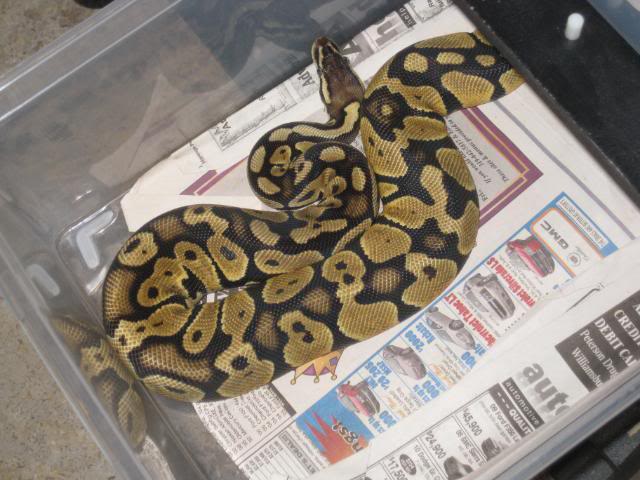
Substrate
I recommend using newspaper, paper towels, butcher's paper, or aspen. I personally use newspaper because paper towels get a little pricey. I use aspen with my hatchlings, they seem to do better on a more natural substrate when they hatch. Last year I tried leaving my breeder girls on newspaper when they laid their eggs and it worked out pretty well. I will still throw in aspen if I think I'm going to be gone when they lay. That way I can wet the aspen and keep the humidity up.
Water Bowl
You can buy reptile water bowls or use other kinds of bowls that won't tip over. That was the biggest problem I had with my water bowls, the snakes always tipped them over! If your snake sits on wet substrate too long they can get scale rot. I've found that souffle bowls work best for me, they are usually used for fancy one-serving desserts (you can see them in the picture of my rack set up above). They can be found in any store that sells kitchen supplies. They are ceramic and very heavy for their size. The bowl does not have to be large enough for your snake to soak in, it just needs to have fresh water! My adults/subadults get dog bowls or PVC cufflings I believe is what they are called, with plastic dishes inside.
Feeding
Feeding every 7-10 days is generaly the best practice. If the snake is skinny you can feed it every 3-4 days (I do this with hatchlings typically), and if they are too fat (you can see white skin between their scales) you can feed once every two weeks. As for the type of prey, mice or rats are what you want to offer the snake. If you are feeding your BP mice you will need to give them more mice every time you feed them. Typically by a year old they can eat at least 2-3 mice per feeding, I believe adult females can eat 6 or more once a week. I luckily only have one mouser which is a male that gets 4 mice per week (if he feels like eating that week). Most people prefer to feed rats since even an adult female only needs one large rat per feeding. BPs, will not outgrow rats, most can't even eat jumbo rats. As for chosing the correct size, you want the prey item to be slightly thicker than the snake. You should be able to see the bump from the prey once it's swallowed. The only time you may not notice the bump is if the snake is huge. It can be hard to see the bump in my large adult females.
Other Care Tips
Stuck Shed?
First, don't waste your money on "shedding aids" from the pet store. I typically don't have many shedding issues, but they do happen from time to time, especially when I have the space heater running. Usually just raising the humidity by moving the water bowl to the warm side of the tub is enough to fix the problem. You could also try misting the snake and the enclsoure. If raising the humidity doesn't work you may need to soak the snake to get the stuck shed off.
When I soak my snakes I put them in a plastic tub with about 1-2 inches of warm water (85-90 degrees). I also like to put a hand towel in with the snake. I soak the snake for about 15 minutes and then run the towel down the snakes body. The stuck shed will usually come right off that way, if it doesn't, soak them for another 15 minutes and you should be all good!
Sexing a BP
There are only two ways to properly sex a ball python: probing and popping. I personally prefer popping because that is the way I was taught. A lot of breeders prefer popping because there is no mistaking what you see (in most cases). If you wish to know the sex of your animal I suggest finding a breeder in your area who can help you sex the animal. You can seriously injury a ball python when probing or popping if you aren't experienced.
I know people have heard of other ways to sex ball pythons: spurs, tail, head, etc. None of which are accurate. If a vet or a breeder tells you otherwise I suggesting finding a new one.
Can I Adopt a BP?
I fully support adopting animals when you have the chance. You can adopt BPs, but they are sometimes hard to find. www.petfinder.com is a great place to find any animal that is in need of adoption. You can type in your zip code and find the closest animals. You should also be able to find local shelters or rescues that have reptiles in your area.
You can also find BPs on Craiglist, but be prepared for an animal that has health issues. Mites and scale rot are pretty common. I've checked out a few BPs from CL and they all had scale rot. Getting a rescue BP does worry me a bit because I don't want my snakes to get sick or infested. Be very careful about quarantining!
What about a pet store?
I don't suggest getting a BP from a pet store because they keep their animals in display tanks which creates many problems for the BP. Pet stores seem to really have an issue with mites and getting the BPs to eat. You can get rid of mites by using PAM (prevent-a-mite I have a link on my FAQ page), but the eating issue will often give new owners a big problem. Like I've said before, BPs are not display tank animals and stress very easily. Without a snug secure hide the animal will become stressed and most likely stop eating. The other issue I've had with pet stores is that they really don't know how to care for BPs. BPs do NOT need a big cage, and in my experience thrive in smaller enclosures. Pet stores also recommend heat lamps, which I do not unless you need them to keep temps up. This does not mean that you can't keep a ball python you got from a pet store, it just means that you could have more issues than someone who bought their BP from a breeder. It's not impossible to bring the snake back to its full potential, but for a new BP owner it can be difficult and quite stressful. Often times the ball pythons I see in pet stores have clearly lost weight and haven't eaten for weeks, if not months. If you do get one from a pet store make sure you get one that looks nice and healthy, not skinny or wrinkly. Remember the pet store is there to make the most profit possible. If that means not giving them proper care to save money on food/husbandry they will probably do it.
Where do I get my information?
My information comes from one of three places: advice on BP.net (ball-pythons.net), advice from fellow breeders, or my own experience. I do not pretend to think that my methods are the best or the only way to care for ball pythons. My suggestions are usually from my own experience as a BP keeper.
Still have questions?
If you have any questions feel free to email me any time! I'm usually pretty good about responding within a few days at most. This is my hobby not my life (for now at least) so bear with me!